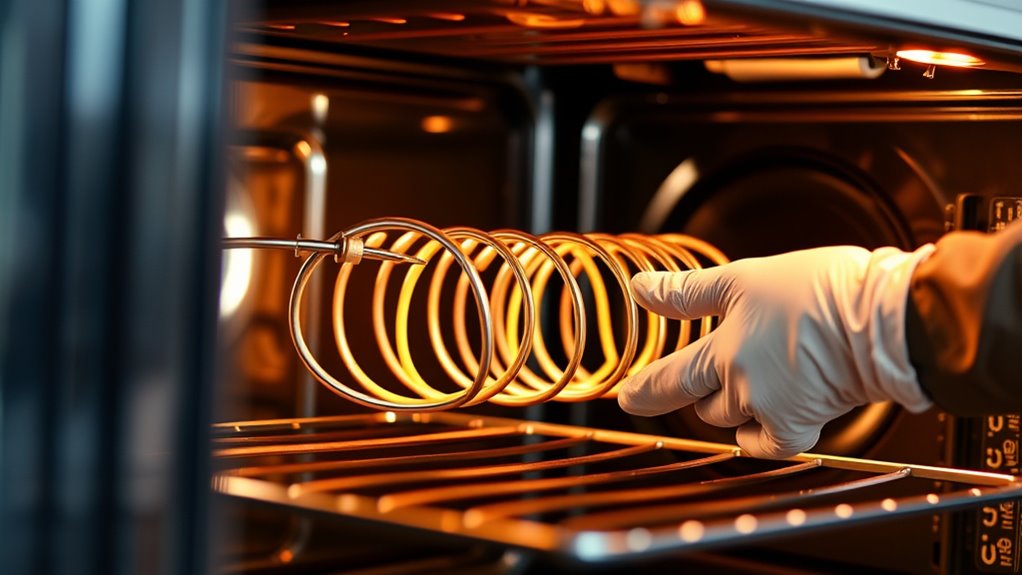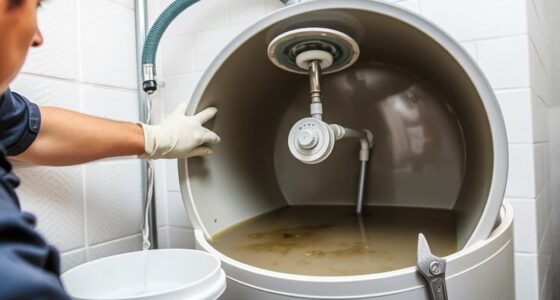To service heating elements in your electric oven, first unplug the appliance for safety. Then, locate the heating elements at the top and bottom, remove any screws or clips, and carefully pull them out. Check for visible damage like cracks or blisters, and test for continuity with a multimeter. If needed, replace the damaged elements with compatible new ones, reconnect everything, and test the oven. More tips can help you guarantee a safe and effective repair.
Key Takeaways
- Turn off power and disconnect the oven before inspecting or removing heating elements.
- Locate and remove screws or clips securing the heating element for easy removal.
- Visually examine the element for cracks, blisters, or breaks, and test for continuity with a multimeter.
- Replace faulty elements with compatible models, ensuring proper wiring connections and secure placement.
- Reassemble the oven, restore power, and run a test cycle to verify proper heating performance.

When your electric oven isn’t heating properly, the issue often lies with the heating elements. Before diving into repairs, it’s essential to rule out other potential causes, such as a miscalibrated thermostat or a faulty oven door gasket. These components can mimic heating element problems, so double-check that your thermostat is calibrated correctly to maintain accurate temperature settings. If your oven’s temperature display doesn’t match the actual heat inside, recalibrating the thermostat might solve the issue without needing to replace any parts. Similarly, a worn or damaged oven door gasket can lead to heat loss, making your oven seem like it’s not heating properly even if the elements are functioning fine. Ensure the gasket seals tightly around the door; if it’s cracked or loose, replacing it can improve heat retention and overall oven performance.
Once you’ve ruled out thermostat calibration issues and a faulty gasket, focus on inspecting the heating elements themselves. Turn off the power supply to avoid electric shock, then open the oven door and locate the heating elements—usually at the top and bottom of the oven cavity. Carefully remove the screws or clips holding the elements in place, and gently pull them out. Look for visible signs of damage, such as cracks, blisters, or breaks in the metal. These are clear indications that the element needs replacing. Even if you don’t see obvious damage, it’s a good idea to test the elements for continuity with a multimeter. If there’s no continuity, the element has burned out and must be swapped.
When replacing a heating element, ensure you get the correct model for your oven. Connect the new element in the same manner as the old one, securing it tightly and ensuring the wiring connections are solid. Before restoring power, double-check that everything is properly in place, including the oven door gasket—since a poor seal can cause uneven heating and affect the oven’s performance. After reassembling, turn the oven back on and run a test cycle to verify that the new element heats evenly and to the desired temperature. Remember, addressing issues like thermostat calibration and oven door gasket integrity can help maintain consistent oven performance and prolong the life of your heating elements. Additionally, using a reliable heating element testing method can confirm proper operation before installation.
Frequently Asked Questions
How Do I Identify a Faulty Heating Element?
You can identify a faulty heating element by first inspecting it visually for cracks, breaks, or blisters. If your oven isn’t reaching the desired temperature, it’s time for an element inspection. Turn off the power, remove the oven’s back panel, and test the element with a multimeter for continuity. If it shows no continuity, it’s defective, preventing proper oven temperature regulation. Replace the element to restore proper heating performance.
Can I Replace Just the Heating Element Myself?
Yes, you can replace just the heating element yourself, turning a broken oven into a DIY repair project. Think of troubleshooting tips as your roadmap—guiding you through disconnecting wires and removing the faulty part. With careful steps and proper tools, you’ll see your oven heat up again, turning a simple fix into a satisfying achievement. Just remember to unplug your oven first and follow safety precautions.
What Safety Precautions Should I Take Before Servicing?
Before servicing your electric oven, prioritize electrical safety by unplugging the appliance and turning off the circuit breaker. Wear protective gear like insulated gloves and safety goggles to prevent electrical shocks and injuries. Confirm the oven is completely cool and dry to avoid burns. Double-check that power is disconnected before working on the heating elements. These precautions keep you safe during the repair process.
How Long Does a Typical Heating Element Last?
Your oven’s heating element is like a faithful torch, glowing steadily until it finally burns out. Typically, it lasts around 8 to 10 years, depending on usage and oven temperature. High temperatures and frequent use can shorten its lifespan, causing it to flicker or stop heating. Keep an eye on performance; when it struggles to reach the desired temperature, it’s likely time to contemplate a replacement.
Are There Energy-Efficient Alternatives to Traditional Heating Elements?
Yes, you can choose energy-efficient alternatives like induction cooktops or ceramic heating elements. These eco-friendly options use less energy and heat up faster, helping you conserve on utility bills. To maximize energy savings, follow tips like preheating only when necessary and avoiding opening the oven door frequently. Incorporating these eco-friendly options and energy-saving tips ensures you’re reducing your carbon footprint while still enjoying efficient cooking.
Conclusion
By inspecting, testing, and replacing your heating elements regularly, you guarantee your oven heats efficiently, maintains consistent temperatures, and prolongs its lifespan. Keeping your heating elements in good condition means better baking results, fewer repairs, and safer cooking. So, stay vigilant, stay proactive, and stay confident in your oven’s performance. With proper servicing, you’ll enjoy reliable heat, delicious meals, and peace of mind every time you cook.










